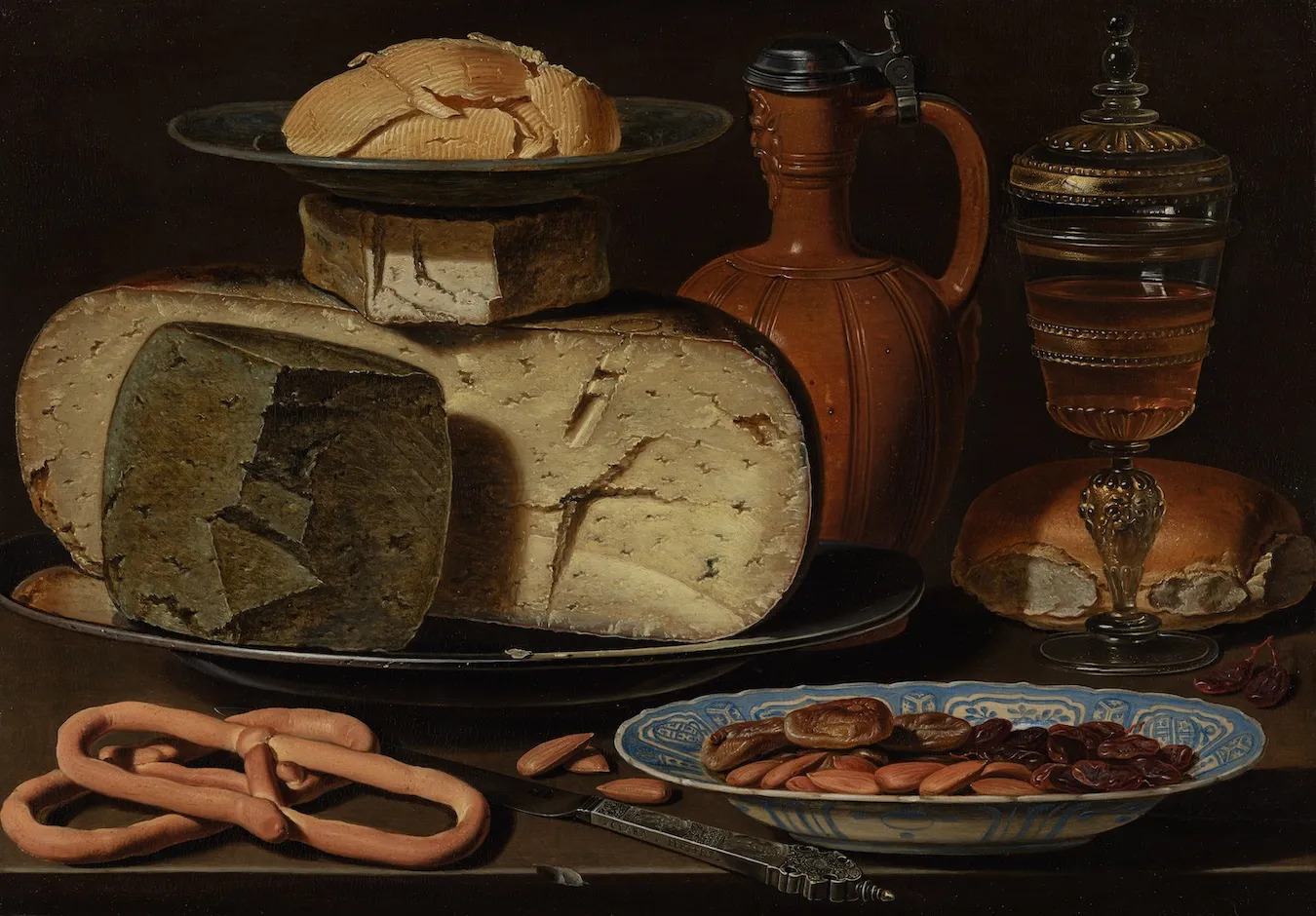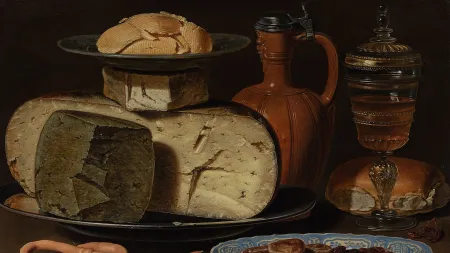
A few years after art historian Linda Nochlin famously asked “Why Have There Been No Great Women Artists?”in a 1971 ARTnews article, she and fellow professor Ann Sutherland Harris came up with an answer of sorts, in the form of a breakthrough exhibition. They curated an impressive show of 150 artworks by 83 artists, titled “Women Artists, 1550–1950,”that opened in 1976 at the Los Angeles County Museum of Art and then traveled to museums in Austin, Pittsburgh, and Brooklyn. It was a major success—its ripple effects are felt to this day.
Nochlin and Harris weren’t making a judgment call about greatness but showing that women had always been artists, sharing some of what they’d created. Their hope was that this exhibition would be the starting point of an important conversation.
“Neither of us believes this . . . is the last word on the subject. On the contrary, we both look forward to reading the many articles, monographs, and critical responses that we hope this exhibition will generate,” wrote Nochlin and Harris in the scholarly catalog published along with the exhibition. “We look forward to future developments.”
In fits and starts, there have been future developments aplenty. In the last decade alone, women Old Masters have been mined from museum storerooms, archives, private collections, footnotes, and other dusty corners. These discoveries have, in turn, been shared through exhibitions and monographs and fostered a general willingness to look more closely.
Below are 12 women Old Masters who have recently benefited from this tide of rediscovery.
-
Plautilla Nelli (1524–1588)

Image Credit: Collection of the Basilica of Santa Maria Novella, Florence. Digital image: Wikimedia Commons. Early art historian Giorgio Vasari barely included biographies of women in his famous anthology, Lives of the Artists (1550), but Renaissance artist Plautilla Nelli made it into the second edition. “She shows that she would have done marvelous things if she had enjoyed, as men do, opportunities for studying, and devoting herself to drawing and representing living and natural objects,” wrote Vasari. “[She] has executed some works with such diligence, that she has caused artists to marvel.”
Nelli was one of the earliest known women to paint historical compositions, and she did this via one of the few avenues available to women of her time: by becoming a nun. She entered the Florentine convent of Santa Caterina as a teen (eventually becoming its prioress), maybe drawn to it because it encouraged artistry among its sisters. There she created religious paintings and codices, and around 20 works are attributed to her now, some of which are housed in important Florentine venues such as Il Museo di San Marco, the Uffizi’s Prints and Drawings department, and the Palazzo Vecchio.
Her crowning achievement was a 7-by-5-meter Last Supper (c. 1568), the first known version of this challenging subject by a woman. After an intensive conservation process supported by the Advancing Women Artists Foundation, the canvas was installed in Santa Maria Novella in Florence in 2019, where visitors can now see it and read the artist’s signature in the upper lefthand corner: Suor Plautilla, orate pro pictora (Sister Plautilla, pray for the paintress). Two years earlier, Nelli was given a solo presentation at Uffizi.
-
Lavinia Fontana (1552–1614)

Image Credit: Collection of the Auckland Art Gallery Toi o Tāmaki. Digital image: Wikimedia Commons. When Lavinia Fontana wed an impoverished nobleman in 1577, the couple signed an unusual marriage contract: She wouldn’t have a dowry but she’d support her husband financially, provided they live in her father’s home and Fontana be allowed to keep painting in the family workshop. It was a smart provision: Eventually the Bolognese artist became the first woman painter to work professionally in Europe (outside a convent or court).
Fontana received 23 prestigious and well-paid altarpiece commissions but is now known mostly for her portraits of Bolognese children and noblewomen. The women of Bologna sought Fontana out, preferring her to other portraitists. “All the Ladies of the City would compete in wishing to have her close to them,” wrote Fontana’s biographer, Carlo Cesare Malvasia, “treating her and embracing her with extraordinary demonstrations of love and respect, considering themselves fortunate to have seen her on the street, or to have meetings in the company of the virtuous young woman; the greatest thing they desired would be to have her paint their portraits.”
Fontana and fellow painter Sofonisba Anguissola were the subject of a two-artist exhibition at Madrid’s Prado Museum in 2019–20, and earlier this year a painting held in storage at a provincial museum in northern France, Portrait of a Gentleman, His Daughter and a Servant, was finally attributed to Fontana. (It had been previously attributed to Flemish painter Pieter Pourbus.)
-
Clara Peeters (ca. 1587–1636)

Image Credit: Collection of the Staatliche Kunsthalle Karlsruhe, Germany. Digital image: Wikimedia Commons. You could almost miss Clara Peeters if you didn’t know to look for her. At first glance her tablescapes look like conventional northern European still lifes, full of exotic extravagances like Chinese porcelain, sculpted pastries, and coins. Take a closer look at the reflective surfaces, though—a goblet, a candleholder, or (as in the lead image to this article) the pewter lid of a beer stein—and there she is in at least eight miniature self-portraits that she sneaked into her compositions. Some of these cameos are just a suggestion of her presence rendered in a few brushstrokes, but in others (such as the one repeated multiple times in the goblet at the far right of Still Life with Flowers, Gilt Goblets, Coins and Shells, above) we see her holding a painter’s palette. Peeters hid herself but also clearly wanted to be found.
Little is known about this figure who left us with the tiniest traces of herself and barely any surviving written evidence, but we do know she was part of a family of artists active in Antwerp. Her husband, father, grandfather, brother, and nephew were all painters, which likely paved a way for her to work as a professional painter too.
There are 39 paintings bearing her signature, with others presumed lost. The Prado has the largest collection of her work, four paintings, and devoted its first-ever monographic exhibition for a woman artist to Peeters in 2016–17 (the exhibition was mounted first in Antwerp at the Koninklijk Museum voor Schone Kunsten).
-
Artemisia Gentileschi (1593–1653)

Image Credit: The Royal Collection, England. Digital image: Wikimedia Commons. Baroque Italian artist Artemisia Gentileschi painted women’s stories differently from how men had always painted them, even at the start of her long career. In one of her first known works, Susanna and the Elders (1610), we don’t see the voyeurism that male artists generally brought to this Old Testament story. The focus is instead on Susanna’s vulnerability and fear. That said, Gentileschi is known for painting powerful heroines both biblical and mythological, introducing agency and complexity to women who otherwise fell flat (if depicted at all).
Much of the early scholarship on Gentileschi, sadly, did that very thing to her—flattening her illustrious career and focusing instead on the rape charges that she brought against her teacher, artist Agostino Tassi. (The trial judge ruled in Gentileschi’s favor; Tassi was sentenced to five years in prison but never served them.)
That approach has since changed; today we know more about this 17th-century superstar whose works were commissioned by patrons like the Medici and King Charles I of England. She was the first woman to be inducted into the Accademia delle Arti del Disegno, which allowed her to buy art supplies without a man’s permission, travel alone, and sign contracts. We also now know that she separated from her husband and lived independently in Naples and London, while supporting her two daughters, who also painted.
Gentileschi has been included in many group shows over the past few decades and had a few solo exhibitions after a 2002 two-artist show at the Metropolitan Museum focused on her and her artist father, Orazio Gentileschi. An exhibition of 40 of her paintings is now on view at the Musée Jacquemart André in Paris, and in June the Getty Museum in Los Angeles will show a previously unknown Gentileschi painting, of Hercules, that was damaged in the large 2020 explosion in Beirut.
-
Giovanna Garzoni (1600–1670)

Image Credit: J. Paul Getty Museum. When Giovanna Garzoni went to the Florentine court of Grand Duchess Maria Magdalena around 1620, looking for a job, a witness said she had more talents than fingers. Garzoni could sing, play music, do calligraphy, and paint miniatures—the latter becoming her focus over the course of her career.
Garzoni painted finely detailed works on a nearly microscopic scale, mostly portraits early on, but as she grew more financially comfortable she focused on what she really enjoyed, botanical still lifes, and by her 40s she was working almost exclusively on them. Still lifes weren’t particularly prized in her day (making them a genre considered suitable for women), but the sense is that this wasn’t a motivating factor in Garzoni’s case. A look at her bowls of fresh fruit specially supplied to her from the Medici gardens or exotic flowers native to Mexico, India, or Japan makes evident her true love of botany.
The painter worked for important patrons across Italy, England, and France, but the majority of her works are still in Medici collections. This made it possible to present a monographic show of her work at Florence’s Pitti Palace in 2020, covering the range of her still lifes and portraits as well as textile work and calligraphy.
-
Michaelina Wautier (1604–89)

Image Credit: Collection of the Kunsthistorisches Museum, Vienna. Digital image: Wikimedia Commons. At a time when many women artists painted still lifes and portraits, Brussels-based artist Michaelina Wautier was an outlier: She created history paintings. Granted, she also painted portraits, genre scenes, and a few religious works. But few women of the 17th century were working on 9-by-12 foot canvases the likes of Wautier’s Bacchanal (c. 1656), a mythological painting in the collection of Austrian Archduke Leopold Wilhelm (one of four paintings by her that he owned). Adding to the self-assurance and skill required to create this monumental work, the artist inserted a self-portrait in the form of a maenad on the far right of the composition, looking confidently out at the viewer.
There are at least 32 known paintings by Wautier, who was well known in her lifetime but then became an obscure name, with many of her works attributed to men. There have been efforts to study her over the past few decades, culminating in a major solo exhibition that will open in September at Vienna’s Kunsthistorisches Museum and then travel to the Royal Academy of Arts in London in 2026.
-
Judith Leyster (1609–1660)

Image Credit: Collection of the Nationalmuseum, Stockholm. Digital image: Wikimedia Commons. Someone took a closer look at the monogram on a “Frans Hals” painting in the late 19th century and realized that a combination of the letters J and L plus a shooting star just didn’t make sense. This sparked the rediscovery of Dutch Golden Age painter Judith Leyster (whose last name means “leading star”) and the rightful reattribution of more than 30 jolly genre scenes, portraits, and still lifes to her.
Leyster shared the loose brushwork of contemporaries like Hals but set herself apart by using a ‘worm’s-eye view” that added interest by casting her sitters from below, and by employing dramatic lamp lighting, one of her contributions to Dutch art. Her figures smoke, play games, drink, and make music—some just being merry and others communicating messages about virtue and vice.
In 2022 the Currier Museum of Art in Manchester, New Hampshire, acquired a Leyster painting of a smiling boy impishly using an upside-down hat as a bowl for grapes. Once owned by LACMA and American television star Red Skelton, the painting now hangs in one of the museum’s European galleries.
-
Louise Moillon (1610–1696)

Image Credit: National Gallery of Art, Washington D.C. Louise Moillon’s still lifes were subdued, unlike the Dutch ones she was exposed to through the Protestant painters from southern Netherlands that she mixed with in the Saint-Germain-des-Prés quarter of Paris. Moillon meticulously painted produce, but with a humility that was more about reverence for the fruits of the earth than a grand demonstration of wealth and exotic specimens.
Moillon was born into a family of artists—her painter father, Nicolas, died when she was young, but then her mother, Marie, married the successful still-life painter François Garnier, who likely trained her. A contract drawn up when Garnier and Marie wed shows that Moillon and Garnier were to share proceeds from painting sales, meaning she was already showing artistic promise at the tender age of 10. A posthumous inventory of Marie’s belongings from 1630 listed around 14 still life paintings that Moillon had created under her own name by the time she was 20 years old. Most of her signed paintings are dated between 1629 and 1637 (her pre-marriage years), and by 1639 Charles I of England owned five of her fruit still lifes.
Last year Getty Publications in collaboration with Lund Humphries released the first English-language scholarly monography devoted to Moillon.
-
Rachel Ruysch (1664–1750)

Image Credit: Detroit Institute of Arts. Rachel Ruysch’s still lifes look realistic but are anything but. The artist assembled impossible bouquets of flowers that bloomed during different seasons, some alive and some preserved by her botanist father. Ruysch grew up in Amsterdam around her father’s plants and collection of curiosities, with access to rare botanicals from distant places at the Hortus Botanicus garden where her father taught. These verdant specimens became part of the roughly 250 meticulously rendered works Ruysch created in her lifetime, a painted universe where flowers that would never cross paths elsewhere flowered alongside lizards and insects.
Ruysch was one of the most famous Dutch painters of the early 17th century, and her work was sought out by patrons across Europe such as Johann Wilhelm II (the elector palatine in Düsseldorf) and the Florentine Medicis. In her lifetime some of her paintings sold for more than Rembrandt commanded during his, but after her death her fame faded.
The first major monographic exhibition of her work, Rachel Ruysch: Nature into Art, recently opened at the Toledo Museum of Art in Ohio after showing at the Alte Pinakothek in Munich; it will later travel to Boston’s Museum of Fine Arts.
-
Rosalba Carriera (1673–1757)

Image Credit: Art Institute of Chicago. They called her the Queen of Pastel. Highbrow travelers visiting Venice knew to find Rosalba Carriera at the house on the Grand Canal next door to the Palazzo Venier dei Leoni (today the home of the Peggy Guggenheim Collection) for graceful miniature or pastel portraits that were easily transportable keepsakes. Fueled by this steady flow of visitors, Carriera’s fame spread across Italy, France, England, and Germany, where Frederick Augustus II of Saxony was her greatest collector. Amassing more than 150 of her pastel works, Augustus II created a designated Kabinett der Rosalba gallery in his palace in Dresden.
Carriera made jewel-like miniature likenesses, sometimes on ivory and inserted into the lids of tobacco snuff boxes, and later in her career worked in pastel—keeping personal recipes for mixing colors and expertly making her own pastel sticks. Rare for her time, she set up her own workshop without a man overseeing business transactions. Helping her there were female students, including her sisters Giovanna and Angela.
Carriera has been included in a few museum group shows recently, and in honor of the 350th anniversary of her birth, in 2023, the Gemäldegalerie Alte Meister in Dresden (which holds the largest collection of her work) hosted a solo exhibition of 73 of her pastels.
-
Adélaïde Labille-Guiard (1749–1803)

Image Credit: The J. Paul Getty Museum, Los Angeles. The most apt portrayal we have of Adélaïde Labille-Guiard is the full-length one she painted of herself and exhibited at the 1785 Paris Salon. In Self-Portrait with Two Pupils (1785) she sits at an easel (in an impossibly clean silk dress), instructing two of her students, Marie Gabrielle Capet and Marguerite Carreaux de Rosemond. By 1783, the year she was admitted to the Royal Academy, Labille-Guiard was teaching nine women students, and in this painting she made her case that more women should have access to studying art. (The Royal Academy had recently capped female enrollment at four.)
Active in the time leading up to the French Revolution (which, sadly, slowed her down in her prime and led to the destruction of some of her work), Labille-Guiard created pastels and oil paintings, many of them portraits, including depictions of members of the extended royal family. One such pastel work, Portrait of Madame Charles Mitoire with Her Children(1783), broke records at Christie’s in 2021 when it was acquired by the Getty Museum. Labille-Guiard is also more accessible now thanks to a recent general-audience biography of her by Bridget Quinn, Portrait of a Woman: Art, Rivalry, and Revolution in the Life of Adélaïde Labille-Guiard (2024).
-
Gesina ter Borch (1631–1690)

Image Credit: Rijksmuseum, Amsterdam. Dutch Golden Age artist Gesina ter Borch has long been classified as an amateur, even though she took her work quite seriously. She was born into an artistic family but never had a formal apprenticeship, nor did she join a guild, publicly show her works, or sell a piece. Her artist father, Gerard ter Borch, trained her brothers intensively, but she started her artistic studies relatively late, and when she did, her dad gave her less guidance.
Still, Ter Borch created a variety of works—self-portraits, watercolors, a copy of a Persian miniature painting, and three large illustrated book projects (held at the Rijksmuseum in Amsterdam since 1886). Many of her works incorporated hand-lettered texts such as poems and song lyrics, the pairing of text and image being a special interest of hers.
Last year the only known oil painting to have been done entirely by Gesina ter Borch was acquired by the Rijksmuseum for 3 million Euros (aided by the Women of the Rijksmuseum Fund). Portrait in Memory of Moses ter Borch (1667–69) is a posthumous portrait of the artist’s younger brother, Moses, who was in the Dutch Navy and died during the Second Anglo-Dutch War. Around the same time, Lund Humphries and Getty Publications released an English-language monograph for her as well.
Plautilla Nelli (1524–1588)

Early art historian Giorgio Vasari barely included biographies of women in his famous anthology, Lives of the Artists (1550), but Renaissance artist Plautilla Nelli made it into the second edition. “She shows that she would have done marvelous things if she had enjoyed, as men do, opportunities for studying, and devoting herself to drawing and representing living and natural objects,” wrote Vasari. “[She] has executed some works with such diligence, that she has caused artists to marvel.”
Nelli was one of the earliest known women to paint historical compositions, and she did this via one of the few avenues available to women of her time: by becoming a nun. She entered the Florentine convent of Santa Caterina as a teen (eventually becoming its prioress), maybe drawn to it because it encouraged artistry among its sisters. There she created religious paintings and codices, and around 20 works are attributed to her now, some of which are housed in important Florentine venues such as Il Museo di San Marco, the Uffizi’s Prints and Drawings department, and the Palazzo Vecchio.
Her crowning achievement was a 7-by-5-meter Last Supper (c. 1568), the first known version of this challenging subject by a woman. After an intensive conservation process supported by the Advancing Women Artists Foundation, the canvas was installed in Santa Maria Novella in Florence in 2019, where visitors can now see it and read the artist’s signature in the upper lefthand corner: Suor Plautilla, orate pro pictora (Sister Plautilla, pray for the paintress). Two years earlier, Nelli was given a solo presentation at Uffizi.
Lavinia Fontana (1552–1614)

When Lavinia Fontana wed an impoverished nobleman in 1577, the couple signed an unusual marriage contract: She wouldn’t have a dowry but she’d support her husband financially, provided they live in her father’s home and Fontana be allowed to keep painting in the family workshop. It was a smart provision: Eventually the Bolognese artist became the first woman painter to work professionally in Europe (outside a convent or court).
Fontana received 23 prestigious and well-paid altarpiece commissions but is now known mostly for her portraits of Bolognese children and noblewomen. The women of Bologna sought Fontana out, preferring her to other portraitists. “All the Ladies of the City would compete in wishing to have her close to them,” wrote Fontana’s biographer, Carlo Cesare Malvasia, “treating her and embracing her with extraordinary demonstrations of love and respect, considering themselves fortunate to have seen her on the street, or to have meetings in the company of the virtuous young woman; the greatest thing they desired would be to have her paint their portraits.”
Fontana and fellow painter Sofonisba Anguissola were the subject of a two-artist exhibition at Madrid’s Prado Museum in 2019–20, and earlier this year a painting held in storage at a provincial museum in northern France, Portrait of a Gentleman, His Daughter and a Servant, was finally attributed to Fontana. (It had been previously attributed to Flemish painter Pieter Pourbus.)
Clara Peeters (ca. 1587–1636)

You could almost miss Clara Peeters if you didn’t know to look for her. At first glance her tablescapes look like conventional northern European still lifes, full of exotic extravagances like Chinese porcelain, sculpted pastries, and coins. Take a closer look at the reflective surfaces, though—a goblet, a candleholder, or (as in the lead image to this article) the pewter lid of a beer stein—and there she is in at least eight miniature self-portraits that she sneaked into her compositions. Some of these cameos are just a suggestion of her presence rendered in a few brushstrokes, but in others (such as the one repeated multiple times in the goblet at the far right of Still Life with Flowers, Gilt Goblets, Coins and Shells, above) we see her holding a painter’s palette. Peeters hid herself but also clearly wanted to be found.
Little is known about this figure who left us with the tiniest traces of herself and barely any surviving written evidence, but we do know she was part of a family of artists active in Antwerp. Her husband, father, grandfather, brother, and nephew were all painters, which likely paved a way for her to work as a professional painter too.
There are 39 paintings bearing her signature, with others presumed lost. The Prado has the largest collection of her work, four paintings, and devoted its first-ever monographic exhibition for a woman artist to Peeters in 2016–17 (the exhibition was mounted first in Antwerp at the Koninklijk Museum voor Schone Kunsten).
Artemisia Gentileschi (1593–1653)

Baroque Italian artist Artemisia Gentileschi painted women’s stories differently from how men had always painted them, even at the start of her long career. In one of her first known works, Susanna and the Elders (1610), we don’t see the voyeurism that male artists generally brought to this Old Testament story. The focus is instead on Susanna’s vulnerability and fear. That said, Gentileschi is known for painting powerful heroines both biblical and mythological, introducing agency and complexity to women who otherwise fell flat (if depicted at all).
Much of the early scholarship on Gentileschi, sadly, did that very thing to her—flattening her illustrious career and focusing instead on the rape charges that she brought against her teacher, artist Agostino Tassi. (The trial judge ruled in Gentileschi’s favor; Tassi was sentenced to five years in prison but never served them.)
That approach has since changed; today we know more about this 17th-century superstar whose works were commissioned by patrons like the Medici and King Charles I of England. She was the first woman to be inducted into the Accademia delle Arti del Disegno, which allowed her to buy art supplies without a man’s permission, travel alone, and sign contracts. We also now know that she separated from her husband and lived independently in Naples and London, while supporting her two daughters, who also painted.
Gentileschi has been included in many group shows over the past few decades and had a few solo exhibitions after a 2002 two-artist show at the Metropolitan Museum focused on her and her artist father, Orazio Gentileschi. An exhibition of 40 of her paintings is now on view at the Musée Jacquemart André in Paris, and in June the Getty Museum in Los Angeles will show a previously unknown Gentileschi painting, of Hercules, that was damaged in the large 2020 explosion in Beirut.
Giovanna Garzoni (1600–1670)

When Giovanna Garzoni went to the Florentine court of Grand Duchess Maria Magdalena around 1620, looking for a job, a witness said she had more talents than fingers. Garzoni could sing, play music, do calligraphy, and paint miniatures—the latter becoming her focus over the course of her career.
Garzoni painted finely detailed works on a nearly microscopic scale, mostly portraits early on, but as she grew more financially comfortable she focused on what she really enjoyed, botanical still lifes, and by her 40s she was working almost exclusively on them. Still lifes weren’t particularly prized in her day (making them a genre considered suitable for women), but the sense is that this wasn’t a motivating factor in Garzoni’s case. A look at her bowls of fresh fruit specially supplied to her from the Medici gardens or exotic flowers native to Mexico, India, or Japan makes evident her true love of botany.
The painter worked for important patrons across Italy, England, and France, but the majority of her works are still in Medici collections. This made it possible to present a monographic show of her work at Florence’s Pitti Palace in 2020, covering the range of her still lifes and portraits as well as textile work and calligraphy.
Michaelina Wautier (1604–89)

At a time when many women artists painted still lifes and portraits, Brussels-based artist Michaelina Wautier was an outlier: She created history paintings. Granted, she also painted portraits, genre scenes, and a few religious works. But few women of the 17th century were working on 9-by-12 foot canvases the likes of Wautier’s Bacchanal (c. 1656), a mythological painting in the collection of Austrian Archduke Leopold Wilhelm (one of four paintings by her that he owned). Adding to the self-assurance and skill required to create this monumental work, the artist inserted a self-portrait in the form of a maenad on the far right of the composition, looking confidently out at the viewer.
There are at least 32 known paintings by Wautier, who was well known in her lifetime but then became an obscure name, with many of her works attributed to men. There have been efforts to study her over the past few decades, culminating in a major solo exhibition that will open in September at Vienna’s Kunsthistorisches Museum and then travel to the Royal Academy of Arts in London in 2026.
Judith Leyster (1609–1660)

Someone took a closer look at the monogram on a “Frans Hals” painting in the late 19th century and realized that a combination of the letters J and L plus a shooting star just didn’t make sense. This sparked the rediscovery of Dutch Golden Age painter Judith Leyster (whose last name means “leading star”) and the rightful reattribution of more than 30 jolly genre scenes, portraits, and still lifes to her.
Leyster shared the loose brushwork of contemporaries like Hals but set herself apart by using a ‘worm’s-eye view” that added interest by casting her sitters from below, and by employing dramatic lamp lighting, one of her contributions to Dutch art. Her figures smoke, play games, drink, and make music—some just being merry and others communicating messages about virtue and vice.
In 2022 the Currier Museum of Art in Manchester, New Hampshire, acquired a Leyster painting of a smiling boy impishly using an upside-down hat as a bowl for grapes. Once owned by LACMA and American television star Red Skelton, the painting now hangs in one of the museum’s European galleries.
Louise Moillon (1610–1696)

Louise Moillon’s still lifes were subdued, unlike the Dutch ones she was exposed to through the Protestant painters from southern Netherlands that she mixed with in the Saint-Germain-des-Prés quarter of Paris. Moillon meticulously painted produce, but with a humility that was more about reverence for the fruits of the earth than a grand demonstration of wealth and exotic specimens.
Moillon was born into a family of artists—her painter father, Nicolas, died when she was young, but then her mother, Marie, married the successful still-life painter François Garnier, who likely trained her. A contract drawn up when Garnier and Marie wed shows that Moillon and Garnier were to share proceeds from painting sales, meaning she was already showing artistic promise at the tender age of 10. A posthumous inventory of Marie’s belongings from 1630 listed around 14 still life paintings that Moillon had created under her own name by the time she was 20 years old. Most of her signed paintings are dated between 1629 and 1637 (her pre-marriage years), and by 1639 Charles I of England owned five of her fruit still lifes.
Last year Getty Publications in collaboration with Lund Humphries released the first English-language scholarly monography devoted to Moillon.
Rachel Ruysch (1664–1750)

Rachel Ruysch’s still lifes look realistic but are anything but. The artist assembled impossible bouquets of flowers that bloomed during different seasons, some alive and some preserved by her botanist father. Ruysch grew up in Amsterdam around her father’s plants and collection of curiosities, with access to rare botanicals from distant places at the Hortus Botanicus garden where her father taught. These verdant specimens became part of the roughly 250 meticulously rendered works Ruysch created in her lifetime, a painted universe where flowers that would never cross paths elsewhere flowered alongside lizards and insects.
Ruysch was one of the most famous Dutch painters of the early 17th century, and her work was sought out by patrons across Europe such as Johann Wilhelm II (the elector palatine in Düsseldorf) and the Florentine Medicis. In her lifetime some of her paintings sold for more than Rembrandt commanded during his, but after her death her fame faded.
The first major monographic exhibition of her work, Rachel Ruysch: Nature into Art, recently opened at the Toledo Museum of Art in Ohio after showing at the Alte Pinakothek in Munich; it will later travel to Boston’s Museum of Fine Arts.
Rosalba Carriera (1673–1757)

They called her the Queen of Pastel. Highbrow travelers visiting Venice knew to find Rosalba Carriera at the house on the Grand Canal next door to the Palazzo Venier dei Leoni (today the home of the Peggy Guggenheim Collection) for graceful miniature or pastel portraits that were easily transportable keepsakes. Fueled by this steady flow of visitors, Carriera’s fame spread across Italy, France, England, and Germany, where Frederick Augustus II of Saxony was her greatest collector. Amassing more than 150 of her pastel works, Augustus II created a designated Kabinett der Rosalba gallery in his palace in Dresden.
Carriera made jewel-like miniature likenesses, sometimes on ivory and inserted into the lids of tobacco snuff boxes, and later in her career worked in pastel—keeping personal recipes for mixing colors and expertly making her own pastel sticks. Rare for her time, she set up her own workshop without a man overseeing business transactions. Helping her there were female students, including her sisters Giovanna and Angela.
Carriera has been included in a few museum group shows recently, and in honor of the 350th anniversary of her birth, in 2023, the Gemäldegalerie Alte Meister in Dresden (which holds the largest collection of her work) hosted a solo exhibition of 73 of her pastels.
Adélaïde Labille-Guiard (1749–1803)

The most apt portrayal we have of Adélaïde Labille-Guiard is the full-length one she painted of herself and exhibited at the 1785 Paris Salon. In Self-Portrait with Two Pupils (1785) she sits at an easel (in an impossibly clean silk dress), instructing two of her students, Marie Gabrielle Capet and Marguerite Carreaux de Rosemond. By 1783, the year she was admitted to the Royal Academy, Labille-Guiard was teaching nine women students, and in this painting she made her case that more women should have access to studying art. (The Royal Academy had recently capped female enrollment at four.)
Active in the time leading up to the French Revolution (which, sadly, slowed her down in her prime and led to the destruction of some of her work), Labille-Guiard created pastels and oil paintings, many of them portraits, including depictions of members of the extended royal family. One such pastel work, Portrait of Madame Charles Mitoire with Her Children(1783), broke records at Christie’s in 2021 when it was acquired by the Getty Museum. Labille-Guiard is also more accessible now thanks to a recent general-audience biography of her by Bridget Quinn, Portrait of a Woman: Art, Rivalry, and Revolution in the Life of Adélaïde Labille-Guiard (2024).
Gesina ter Borch (1631–1690)

Dutch Golden Age artist Gesina ter Borch has long been classified as an amateur, even though she took her work quite seriously. She was born into an artistic family but never had a formal apprenticeship, nor did she join a guild, publicly show her works, or sell a piece. Her artist father, Gerard ter Borch, trained her brothers intensively, but she started her artistic studies relatively late, and when she did, her dad gave her less guidance.
Still, Ter Borch created a variety of works—self-portraits, watercolors, a copy of a Persian miniature painting, and three large illustrated book projects (held at the Rijksmuseum in Amsterdam since 1886). Many of her works incorporated hand-lettered texts such as poems and song lyrics, the pairing of text and image being a special interest of hers.
Last year the only known oil painting to have been done entirely by Gesina ter Borch was acquired by the Rijksmuseum for 3 million Euros (aided by the Women of the Rijksmuseum Fund). Portrait in Memory of Moses ter Borch (1667–69) is a posthumous portrait of the artist’s younger brother, Moses, who was in the Dutch Navy and died during the Second Anglo-Dutch War. Around the same time, Lund Humphries and Getty Publications released an English-language monograph for her as well.

A Waterfront Compound on Washington’s San Juan Island Is Heading to Auction

Cosmoprof Vegas 2025: K-beauty’s Rebirth, Mood-driven Beauty Grows

Apple’s upcoming iPhone lineup is the most exciting we’ve seen in years

The Eagle Is Branded: The American Unveils First Conference Mascot


